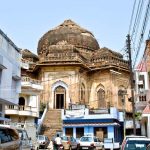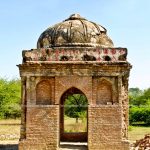Mayfair
Rise and Fall of a Victorian Curtain
At the beginning of 1930, the prominent buildings in and around Hazratganj were the Jahangirabad Palace, P.M.G office building, District Magistrate’s residence opposite it, St. Joseph Church, East Indian Railway building, Central Bank building, Allahabad Bank building and Jahangirabad Mansion on Ashok Marg. Right across the road of St. Joseph Church was an open ground with huge trees where people on a stroll to Hazratganj would sit down and wile away time eating peanuts from vendors.
During this period some families from Karachi, Hyderabad (in Pakistan), Rawalpindi and Lahore had already started migrating to Lucknow. Among them were three Sindhi families who, in course of time, left a lasting impression on the social fabric of the city. They were the families of C.V Advani, Hiranand Mansukhani and Seth Gyan Chand Thadani. Mr. Advani had been doing the business of book selling and, initially opened a bookshop at a space in what is now Gandhi Ashram; Mansukhani had been trading in silk and went on to do contractual business in Lucknow. Gyan Chand Thadani got the management of running Prince of Wales Cinema and also the Regimental Cinemas in cantonment. Mr. C.V Advani, father of Ram Advani, helped Seth Gyan Chand in running these cinemas.
In 1937 Thadani got the vacant ground opposite St. Joseph Church on 99 years lease from its owner, Raja Eijaz Rasul Khan of Jahangirabad, and decided to build a cinema hall over here. After some administrative hiccups, due to the proximity of a church, the hall was ready to open in 1939. Gyan Chand Thadani wanted to name it as Metropole, but for some strange reason, he changed his mind at the last moment and got it registered as Mayfair. A restaurant on the ground floor next to the hall and a ballroom on the first floor, both by the name of Mayfair, were added attractions in this entertainment hub. Times of India has, incidentally, reported on 22.5.2015 in its coverage of Ganj, that Mayfair Cinema Hall was initially a ballroom and live shows were also staged in it. This is not true and the same can be confirmed from Mr. Ram Advani, who was there from the very beginning that Mayfair had been a cinema hall right from day one and the referred Ballroom was on the first floor, which later on became the premises of British Council Library. Furthermore, there were no stage performances in Mayfair as there was hardly any space in front of the screen to be called a stage.
Anyway, with additions of these entertainment joints, a typical evening out, especially for the British, would be dance at the ballroom, followed by drinks and dinner at Mayfair Restaurant or at Valerio’s and late night movie at Mayfair. There was a live orchestra on weekends at the Ballroom, highlight of which was in the form of a crooner named Miss Fanthome. Seth Gyan Chand Thadani had also imbibed the English spirit and came to be known as Mr. Thad. (He reverted back to Gyan Chand Thadani after Independence)

Mayfair Hall never had an elevated balcony; instead, the rear section was raised high up and was called Dress Circle. Entrance to this section was from the wide and flaring out stairs from outside. The seating capacity was a little less than 500 and the first English movie to be screened was of Laurel & Hardy. A Victorian style curtain rose up and fell down slowly on the screen after each show. In the beginning there were only two shows- evening show starting at 6 PM and night show at 9 PM. Then as the trend of watching Hollywood movies gathered momentum and the need of entertainment gained priority, noon and matinee shows were introduced. But the most exclusive and biggest draw was the Sunday Morning Show at Mayfair. It has to be mentioned that when the morning shows were started in the 1960s the viewers comprised mainly of the youths of the town and as the shows gained popularity well known senior citizens also started coming in droves. Sunday Morning Show became not just showbiz but it got the stature of a weekly carnival where the celebrity and the commoner wished to be seen. For the ladies the walk from the verandah outside right up to the stairs leading into the Dress Circle was nothing less than the red-carpet walk seen at Cannes Film Festival; it didn’t matter what film was being screened. And as the shows became the talk of the town, the importance of a stern looking Kumar Sahab, the manager, became two-fold because getting hold of tickets of a limited number of seats required either early planning or string pulling. Kumar Sahab had been trained by Mr. C.V Advani and had been associated with Mayfair since years. He had acquired sternness due to the pressures of his job, though he would share a joke and smile profusely in privacy. He had meticulously built decorum for the viewers and did not tolerate bawdy or rowdy behavior within the premises. I had actually seen him slapping a rowdy character who misbehaved at the ticket window and had him literally thrown out of the premises.
As said earlier Mayfair Building was the entertainment hub of the British, hence, from inception only English movies had been screened in the cinema hall. This tradition was continued by Mr. Thadani even after the presence of the Anglo-Indian had receded and though, at times, the night shows may have run into losses, they, nevertheless, persevered. Showcasing Hollywood movies at Mayfair was not just a business proposal for the distributors, it was a matter of pride for them and a movie that got screen space at Mayfair automatically got an enhanced rating. Hollywood blockbusters starting from Laurel & Hardy movies of the silent era to Gone With The Wind, My Fair Lady, onto the Bond movies, Pink Panther series, Carry On series, Hitchcock mysteries, horror, suspense, war, romance, in short, box-office hits of every genre of English movies had been shown at the one and only Mayfair.
The foyer and stairs were always spotlessly clean and the walls were decorated with large size framed photographs of leading stars of Hollywood, as well as, some of the Bollywood legends of that era. I remember the frames of Dilip Kumar, Raj Kapoor, Shammi Kapoor and Dev Anand giving company to David Niven, Burt Lancaster, Kirk Douglas, Sophia Lauren, Elizabeth Taylor, John Wayne, Sean Connery, Raquel Welsh, Gina Lollobrigida, George Peppard, Ursula Andress, Clint Eastwood, Yul Bryner, Barbara Streisand, Paul Newman, Robert Redford and Frank Sinatra. The display panels of current and forthcoming movies were appropriately updated on a weekly basis and peering at these panels was no less important than the trailers.
When the show started the drawn curtain would rise up slowly and after the statutory documentary the trailers of forthcoming movies would be shown. After the trailers were done with, the Interval would be announced on the screen and the lights would be on. There were no vendors of cold drinks, popcorns or samosas, hence, if anyone wanted a quick bite, he or she would rush to Kwality Restaurant next door to buy some pasties or pastries. After the interval the movie would start and continue uninterrupted till the end.
A few years before Independence, Mr. Thadani opened his second hall, Basant, on the same ground but the front of this hall was towards Lalbagh Road. Thadani never ran this hall himself, but gave it to Mr. Sahni to run and operate. This hall showed mainly Hindi movies, while Mayfair continued with its run of English movies till 1972. Pakeezah, starring Meena Kumari and produced and directed by Kamaal Amrohi, was ready for release. Shaukat Mirza, a co-producer, wanted the film to be released in Lucknow in none other than Mayfair Cinema Hall. Knowing well that only Hollywood film were shown in this theatre, he came specially to persuade Mr. Gullu Thadani, son of Seth Gyan Chand, who was reluctant to break the tradition of showing only English movies. After a lot of persuasion it was finally agreed between the two that Pakeezah would be released and shown at Mayfair for only one week and then it would be screened at some other hall.

Accordingly, the film was released on 4th February 1972 and created history. Pakeezah was not an instant hit in other cities and picked up business two months later after the death of Meena Kumari. But in Lucknow it was a hit right from the first day itself. The queue for tickets of every show extended till Lalbagh on all days of the week. As a result, the film, which was supposed to run for a week at Mayfair, continued to be screened for almost 2 years.
Then Bobby came and the applecart of Hollywood movies turned turtle forever, Like Mirza, Raj Kapoor too, insisted on Bobby being released at Mayfair. Pakeezah had already broken the convention, as such; Gullu Thadani could not refuse Raj Kapoor, who was also a family friend. Bobby was a trendsetter and broke all box-office records of the past. It was released in November 1973 and ran in this hall for 4 years and 5 months, something that is beyond comprehension at present times. In these four and half years Raj Kapoor was ready with his next venture- Satyam Shivam Sundaram. While Bobby was still running in its fifth year, Satyam Shivam Sundaram had created quite a flutter in the form of posters of a scantily clad Zeenat Aman pinned on the display panels at Mayfair. The movie got released on 22nd March 1978 and continued to run for one and half year. Thus, in a matter of 8 years only three movies had been shown at Mayfair and all of them were Hindi movies, which broke the 33 years old tradition of the cinema hall.
Thereafter, Mayfair showed a mixed bag of some English and mainly Hindi movies at a time when film screening was undergoing transformation of singleton halls to multiscreen complexes. During this period several picture halls had closed down in Lucknow and one day in 1996, out of the blue, doors of Mayfair did not open in the morning and a notice was on display that Mayfair was closed for goods. The 57 years old cinema hall, which started with silent movies, went silent without even uttering a whimper. Gullu Thadani would best know the reason for the closure of Mayfair, but at least he could have informed his next-door neighbor and long time friend, Ram Advani, what made him take this unilateral decision.
(Published in The Lucknow Observer, Volume 2 Issue 15, Dated 05 June 2015)

Independence Day Celebration @ Mayfair, Hazratganj (August 15, 1947)




